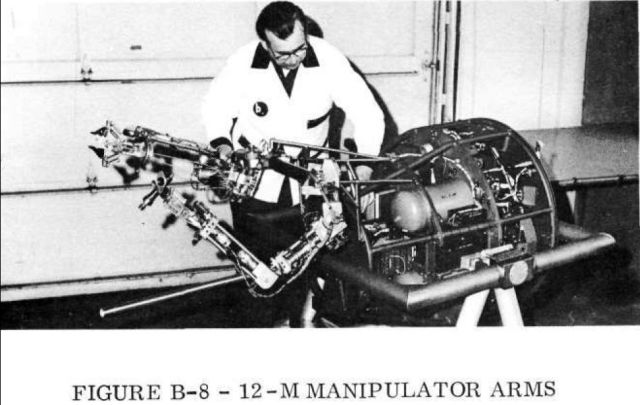
Spacemen Get Long Reach with Remote-Control Aids
By WERNHER von BRAUN
PS Consulting editor, Space
Sophisticated puppets called "teleoperators" can relieve our astronauts of many difficult or dangerous tasks performed in orbit
When one of our coming Space Shuttles repairs a satellite in orbit, or retrieves it for return to Earth, it's likely the job will be done by remote control. Sometimes the actual operator may not men be one of the Shuttle crew, but a man down on the ground.
Little-realized by the public is how extensively the manned Shuttle will rely on unmanned devices and vehicles to perform its orbital tasks. The Shuttle's aids, including a novel crewless mini-spacecraft named the Free Flyer, will be among the most sophisticated of the remote-controlled machines we all "teleoperators"-and will be described here before we are through.
A teleoperator has been defined as "a general-purpose, dexterous, cybernetic machine." "Cybernetic," or capable of intelligently guided actions, distinguishes teleoperators from preprogramed automatons like phonograph record changers, or timer-controlled washing machines. It establishes that man himself is always "in the control loop."
Teleoperators have found favor wherever man wants to perform a difficult task in an environment that is hostile-because of heat, pressure, radioactivity, a vacuum (requiring man to encapsulate himself in a clumsy space suit)- or sheer distance, as to other worlds that man can explore only by proxy at the present stage of space-flight technology.
What teleoperators can do. Some outstanding exploits of teleoperators to date offer examples of the key parts they can play in our conquest of space: When our unmanned Surveyor 3 spacecraft soft-landed on the moon in 1967, out went a toy-sized scoop on a lazy-tongs arm, radio-controlled from a pushbutton console on Earth. By digging tiny trenches, it showed the consistency of lunar soil firm enough for astronauts to land and walk upon, before they arrived. A picturesque Soviet teleoperator, an unmanned eight-wheel roving vehicle called Lunokhod, was soft-landed on the moon in 1970 before our Apollo crews began bringing man-driven cars along. Operated from Earth by a crew of five, Lunokhod roamed the lunar surface for 10 1/2 months with TV eyes (PS, July '71). Twice the Russians have accomplished the extraordinary feat of gathering moon samples with a core drill on an unmanned soft-lander, and bringing them back to Earth. Luna 16 did it in 1970, and Luna 20 this year.
Not all teleoperators call for remote control over such long range as the quarter-million-mile lunar distance of these examples-or the vast interplanetary distance to Mars, to operate our Viking lander that will seek signs of life on the Martian surface in 1976. Most teleoperators are actually manipulators whose mechanical hands duplicate the motions of an operator's hands, at comparatively close range. More than 3000 manipulator arms have been built in the U.S. since 1948, most of them to handle radioactive objects safely in atomic laboratories. During a visit to the Oak Ridge National Laboratory, I had an opportunity to marvel at the dexterity of such a cable-operated manipulator system. Working with both hands, I learned within about 10 minutes to open a matchbox placed behind a thick glass window, remove a single wooden match, close the box again, and strike the match! These arms' mechanical control gives a remote sense of touch. Electric or radio control makes such a "force feedback" more complicated, but not impossible to provide. Beginning in 1961, manipulators to grasp submerged objects have been fitted to submarines and undersea robots. Adapting them for space has followed–and our Space Shuttle will be a showcase of their development.
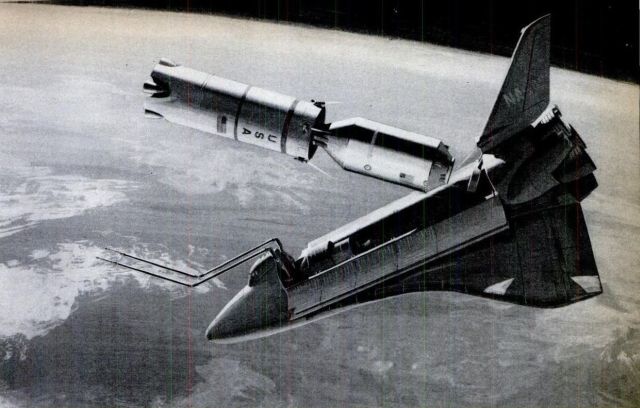
Remote-controlled gear for the Shuttle- To deploy and retrieve payloads, the Space Shuttle will have an attached manipulator consisting of ono to two giant mechanical arms-hinged booms up to 50 feet long, waved like "feelers," and equipped with television viewers. But the Shuttle's remarkable equipment with teleoperators does not end there.
A Free Flyer, expected to be carried aloft in the Shuttle's cavernous 15-by-60-foot cargo bay, will be a mobile teleoperator. Scooting through space under radio control from the Shuttle's cabin, it will dock itself to satellites rendezvoused by the Shuttle, and repair or recover them.
As presently pictured, the unmanned box-shaped craft will measure only 48 by 36 by 32 inches and weigh about 400 pounds. Up to 16 hydrazine thrusters will propel it and govern its attitude.
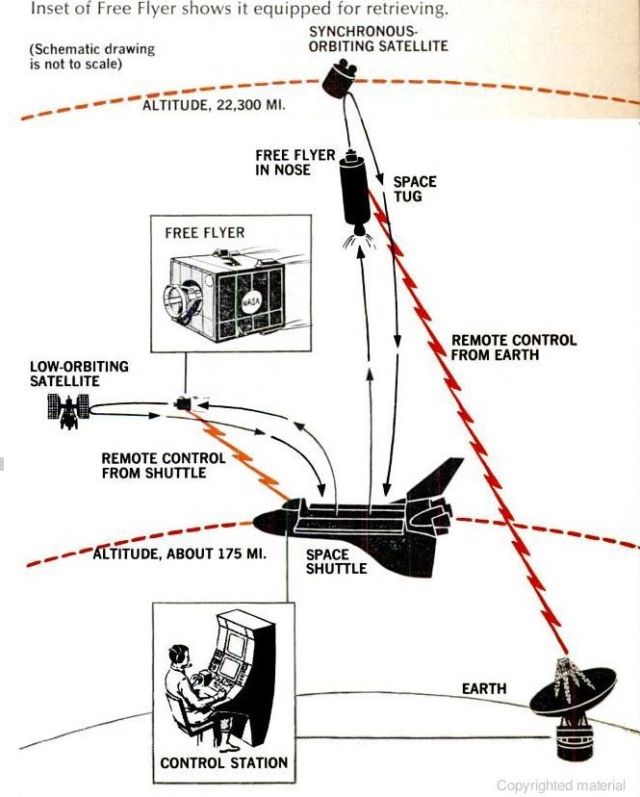
At its business end the Free Flyer will mount any of a variety of interchangeable fittings—manipulator arms, and replacement modules of satellite parts, or a satellite-retrieving hitch for its "go-fetch-it" role.
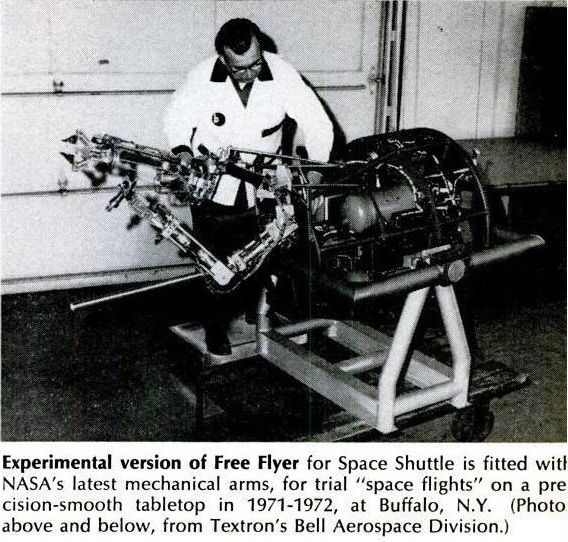
A TV camera peeping from its top, on the end of an extendable boom, and two others at strategic places, provide close-up control-console views of oper-ations too distant to observe from Shuttle windows. Its flights may be close-range ones, of 50 to several hundred feet, or may extend to a distance as for as several hundred miles.
For missions such as launching a synchronous satellite into the required 22,300-mile-high orbit, the Shuttle's orbiting altitude of some 175 miles will fall far short. So its cargo bay will carry a Space Tug—an unmanned, orbit-to-orbit rocket vehicle-to take high-flying satellites the rest of the way. The Free Flyer can ride the nose of the same Space Tug to high orbit, detach itself to fix or latch onto a satellite, and hitch a ride back down again. During its operations in synchronous orbit the Free Flyer will be controlled from Earth, where a synchronous satellite hangs stationary overhead—rather than from the fast-orbiting Shuttle, whose line-of-sight control path to the Free Flyer would to obstructed by the Earth's bulk every 45 minutes or so.
Trials simulate flights. Pioneer "space flights" of an experimental Free Flyer took place on a 480-square-foot tabletop at Buffalo, N,Y., in trials for NASA concluded last February by Textron's Bell Aerospace Division.

The weird mobile machine rode a three-cornered air-cushion platform that could glide without friction across the table's precision-smooth and flat surface of plastic-coated aluminum. Twelve nitrogen-gas thrusters propelled it in any direction or rocked it in its gimbal mounting. Its equipment included NASA's latest in mechanical arms, called the Model 12-M General Purpose Anthropomorphic Manipulator.
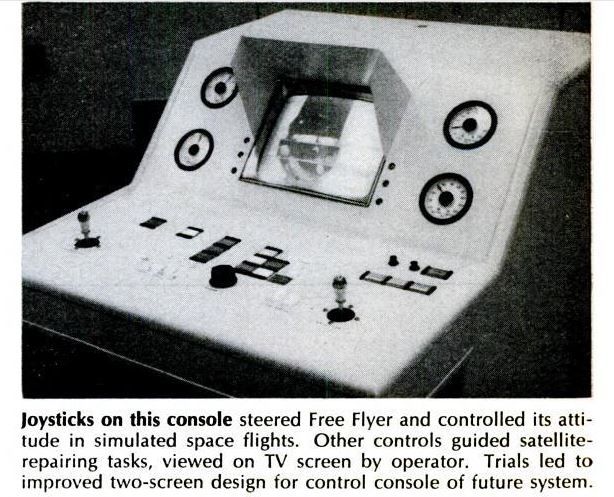
Its "pilot" guided it with miniature joysticks on a control console where TV screen, linked to a camera on the moving machine, gave him his only view of its maneuverings. A simulated "satellite" at the table's end was its target.
In a series of trials, the experimenal Free Flyer succeeded in docking to the satellite, with a simple rodlike probe that latched within a guiding one. By remote control, it removed and replaced a satellite's thruster assembly, installed and extended a whip antenna, and replaced a battery. It proved a satellite could be refueled in orbit, by connecting and disconnecting a coupling for transferring fluids.
It detected damaged solar-panel cells, fractured and eroded as if by meteoroid showers. It opened a port cover, poked a mirror inside, and inspected a valve and electric wiring.
Shuttle repair, caddying, rescue. An August 1972 report to NASA by Bell Aerospace sees many uses for the Free Flyer besides the repertory already cited- Among them:
• The mini-spacecraft could inspect the Shuttle's heat shield before re-entry–and carry a repair kit to apply a temporary patch of thermal shielding material if needed.
• While a Free Flyer can handle a satellite skillfully–and most safely, if it's tumbling over and over in orbit, studies now indicate- there may still be extravehicular tasks for spacewalkers. The Free Flyer could offer them caddy service" to carry cumbersome parts. If an astronaut forgot a tool, or needed a special one, he could send the Free Flyer back for it. An astronaut himself could hitch a ride to his work site, and back again, on the little spacecraft.

• Perhaps most dramatically, the Free Flyer could speed to the rescue of a "man overboard," adrift in orbit as pictured above. Well-padded "grappler" arms would gently enfold him and bear him to safety.
And there you have a preview of teleoperators we may see in space by the time, expected to be before 1980, when the Space Shuttle becomes operational.
Source: Popular Science, November 1972.
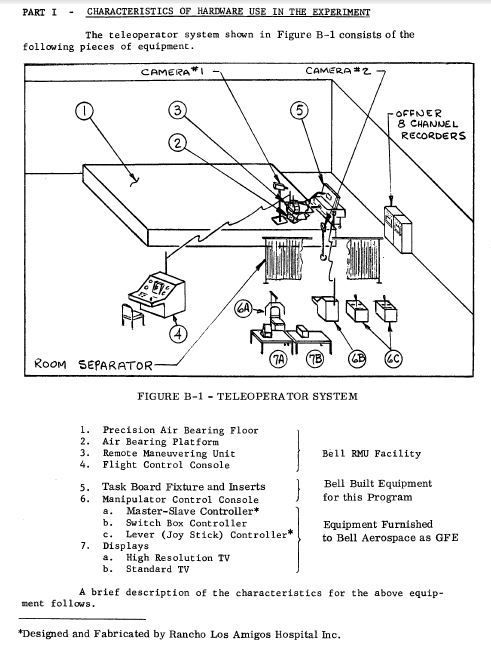
Figure 1 shows the facility and the equipment used in the empiral program. It includes the Bell 5 DOF simulation facility consisting of the Precision Floor (1), and the Air Bearing Platform (2), a Remote Maneuvering unit (RMU) (3), and a Flight Control Console (4). The RMU is a self-contained laboratory satellite with all subsystems required to simulate space maneuvering with a high degree of fidelity. It is maneuvered from the Flight Control Console The task board (5), accepts six different work-piece inserts designed for the experiment program, and it provides a docking fixture representative of a passive spacecraft.
The NASA furnished equipment includes the 12-M general-purpose anthropomorphic manipulators, three controllers, and two closed-circuit TV systems. The 12-M manipulator shown in Figure 2 was installed on and integrated with the RMU. This manipulator was designed and fabricated by the Rancho Los Amigos Hospital, Inc., and consists of a right and left arm, each having seven degrees-of-freedom.


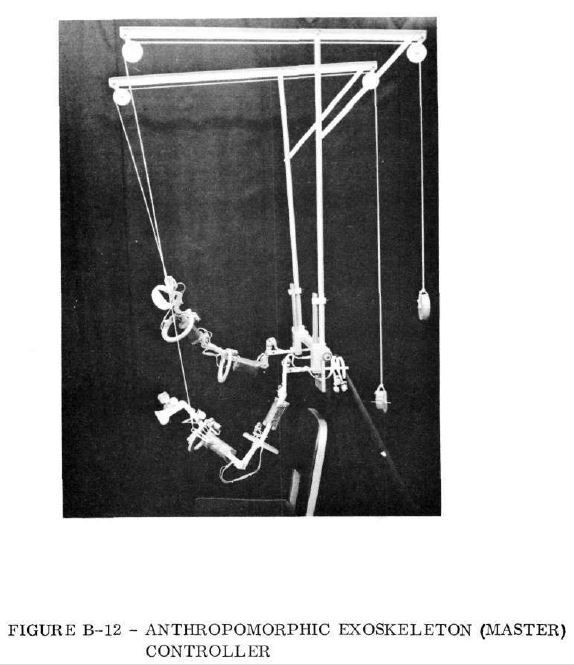
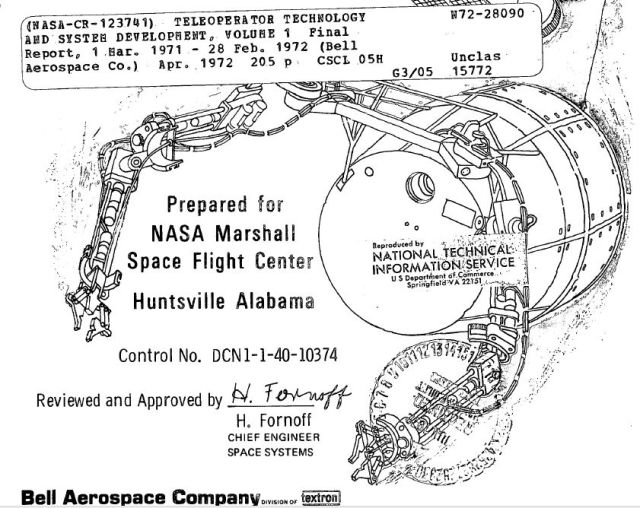
The cover of the report clearly shows the Rancho Los Amigos manipulator arms.
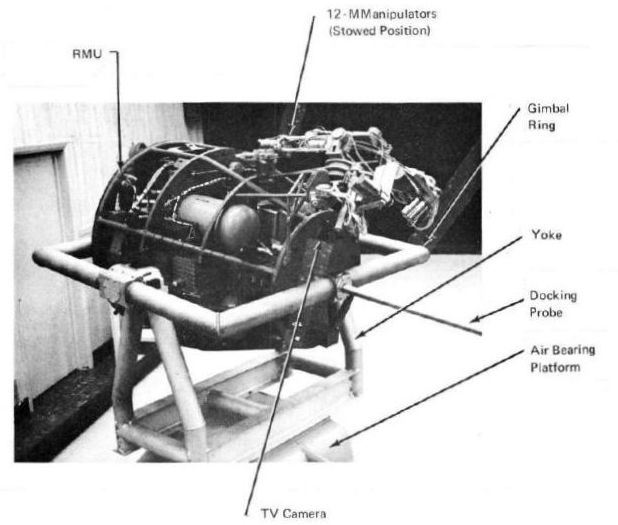
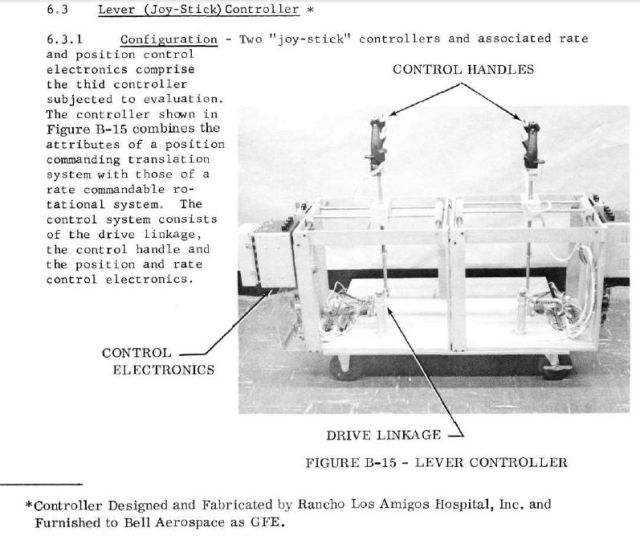
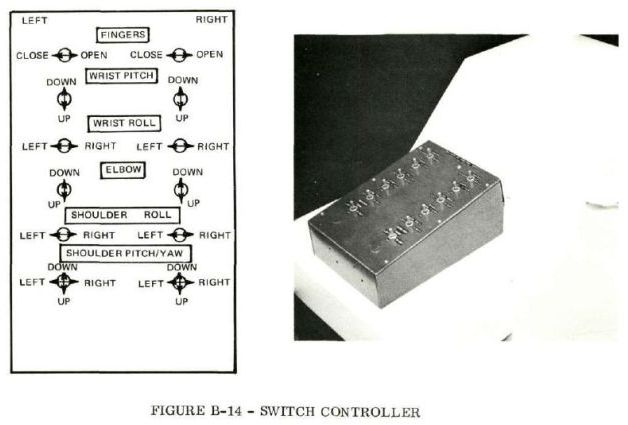
The Rancho Los Amigos Arm was a leader in its time. Originally designed as a powered orthosis, copies were modified for Stanford Artificial Intelligence Laboratory's "Hand-Eye" robot in 1967, used in the 1977 movie "Demon Seed" for Joshua the robot, and for the 1969 Self-propelled Amthropomorphic Manipulator (SAM).
See other early Space Teleoperators here.
See other early Lunar and Space Robots here.